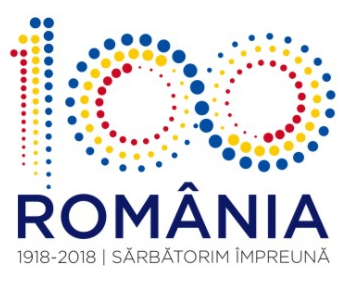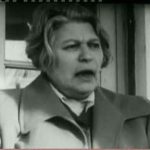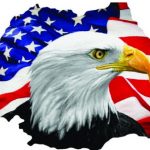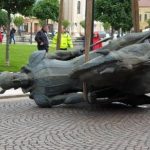Scrisoare către români, evrei și alte etnii cu „Reisepass für Hölle”
Am citit recent un articol din nr. 47 al publicației israeliane în limba română „Curierul de pretutindeni”, cu referiri și calificative privind recenta manifestare din cadrul Academiei Române, având ca subiect împlinirea a 100 de ani de la descoperirea insulinei (pancreinei cf. N. Paulescu). Prof. dr. Jean Jaques Askenasy, „membru de onoare al Academiei Române”, nu precizează în textul preopinent citat niciun fel de argument sau demonstraţie care să anuleze meritele ştiinţifice ale lui N.Paulescu, de altfel, foarte „greu de contestat”.
În articolul cu pricina, autorul articolului susține: „De condamnat este atunci când îți însușești niște merite sau niște priorități care nu îți aparțin și, mai ales este de condamnat alegerea unor priorități false ale unor oameni care au abdicat de la minima morală”. Nici Profesorul Jean Jaques Askenasy (membru corespondent nu este – sine die – academician al vreunei Academii Naționale, așa cum eronat a fost etichetat profesorul Askenasy – n.n.). şi nici altcineva nu au venit până astăzi cu argumente irefutabile contrare privind descoperirea pancreinei-insulinei de către N. Paulescu.
Având în vedere că „în anul 1971, fiziologul scoţian Ian Murray a iniţiat o campanie în urma căreia lui Nicolae Paulescu i-au fost recunoscute meritele post-mortem de către vicepreședintele «Fundației Nobel de la acea vreme în ceea ce privește descoperirea insulinei »”[1], este posibil ca aflat la o vârstă respectabilă (n.1929) profesorul Askenasy să fi dat un rateu neurologic, negând meritele savantului român.
Împortant este că pancreina a fost descoperită de către un român și milioane de oameni beneficiază de pe urma ei, dar, regretabil, în opinia autorului articolului, acest argument nu este relevant.
În text se amintește numele medicului nazist Mengele. S-a demonstrat că dr. Mengele a fost un medic care a sfidat și încălcat legile umanității, dar Jean Jaques Askenasy se înșeală asupra (ne)utilizării în medicină a rezultatelor „experiențelor” lui, obţinute prin metode condamnabile. Dacă tot au fost efectuate, rezultatele trebuiau ignorate doar pentru că au fost efectuate contrar legilor umanității?
Despre semiți și anti-semitism
De mulți ani combat folosirea deliberat-tendențioasă și eronată a expresiilor SEMIT, SEMITISM, ANTI-SEMITISM, pe care remarc că o folosește și autorul articolului în discuție. Ce înseamnă SEMIT conform dicționarului explicativ al limbii române?
SEMÍT, -Ă, semiți, -te, s. m. și f., adj. 1. S. m. și f. Persoană care face parte din grupul de popoare, apropiate între ele prin limbă și prin aspect fizic, din sud-vestul Asiei, nordul și estul Africii, căruia îi aparțin astăzi ARABII, SIRIENII, EVREII, 2. Adj. Care aparține semiților (1), privitor la semiți; semitic. – Din fr. Sémite.
Semite sunt toate triburile lui Sem, iar triburile israelite – Fiii lui Israel sau Semințiile lui Israel sunt diviziunile tradiționale ale poporului iudeu vechi (Geneza 29:32-35, 30:1-20 – n.n.)
Într-un text-pamflet scriam ironic că S.U.A. sunt state anti-semite pentru că luptă împotriva arabilor (semiți). Ironic, dar adevărat.
În concluzie, urmând logica prostului, putem afirma că S.U.A. și Israel sunt state antisemite pentru că au luptat/luptă împotriva sirienilor, a arabilor… Nu?
Personal, respect pe oricare individ, de orice etnie, care se află pe pământ românesc și nu numai, care respectă tradițiile și legile Neamului Românesc – fie el român, evreu, țigan, rus, german, indian, chinez… dar cer judecată dreaptă și pedepsirea conform legilor Țării Mele a oricărui individ care comite fapte reprobabile împotriva nației mele, fie el român, evreu, țigan, rus, german, indian, chinez… Este ceva incorect? Este ceva care deranjează? Pe cine?
Citez cuvintele unui mare român, cuvinte care pot pecetlui începutul fiecărei „Constituții” a oricărui stat suveran, cuvinte valabile pentru oricare nație: „Fii bun, fii drept și nu uita că deasupra intrigilor și urilor este Patria, este veșnicia Neamului și acolo trebuie să ne întâlnim întotdeauna, chiar dacă nu ne înțelegem de fiecare dată!”.
Copiii tâmpiți întărâtă câinii de dincolo de gard
Util ar fi, ca de la om de ştiinţă, academician, la om de rând, să ne unim pentru a opri catastrofa aruncată asupra întregii omeniri de către niște bogătaşi cu minţile rătăcite, tirani iresponsabili, care se cred dumnezeii planetei.
Există, însă, specimene precum Alexandru Florian și Andrei Muraru, care aduc mari deservicii atât românilor, cât și evreilor de bună credință din ambele popoare. Cei doi au apucăturile unor copii tâmpiți care întărâtă câinii de dincolo de gard, stârnind furia viețuitoarelor, dar care, când vine momentul de a sta față în față cu „dușmanul”, își pun coada pe spinare și dau bir cu fugiții. V-ați întrebat Qui prodest?
Vă spun eu: nici românilor nici evreilor cinstiți, doar sectanților globaliști, practicanți ai dictonului latin „Divide et impera!”.
Rogu-vă, Români și Evrei, deopotrivă, nu mai dați apă la moara extremiștilor șovini de genul non-valorilor Alexandru Florian, Andrei Muraru și altora de teapa lor! Nu fac cinste nici rasei umane, nici popoarelor din care se trag. Nu sunt altceva decât un fel de imitatori iresponsabili ai lui Adolf sau clone dotate cu demență senilă, precum actualul „Mare Șef” de la Casa Abă.
Să lăsăm pe fiecare popor în parte să-și judece cu dreptate fiii, să evalueze cu corectitudine și fără influențe străine valoare lor reală, să-i pedepsească pe cei vinovați și să-și onoreze valorile. E ușor de arătat cu degetul ipoteticul și mereu prezentul „vinovat”
– capra vecinului, dar nici Istoria, nici Justiția nu se fac cu „dacă” și „poate”, ci cu fapte.
Excese s-au făcut întotdeauna și de o parte și de cealaltă:
– Ariel Sharón și șeful Statului Major israelian s-au spălat pe mâini precum Pilat din Pont în cazul masacrului comis în taberele de refugiați de la Sabra și Shatila, unde, conform raportului „Crucii Roșii Internaționale”, între câteva sute și 2.400 de palestinieni au fost asasinați, caz despre care se păstrează încă „Omerta”, deci „bubele” din ograda proprie nu se pun…
– Alexandru Florian și Andrei Muraru n-au fost deranjați și au făcut „ciocul mic” când în cursul acestui an, criminalul Albert Wass – asasin de români şi evrei – a fost reabilitat de către o instanță subordonată nu dreptății, ci ordinelor politice.
A sosit timpul să spunem: Ajunge!
Haideți să ascultăm împreună „Trei culori”, opera lui Ciprian Porumbescu, să ascultăm împreună „Hatikvah” cu versurile lui Naftali Herz Imber: „Fraților, credința noastră s-o păzim!/ De pe drumul crucii, să nu rătăcim,/ De pe calea sfântă, să nu dăm înapoi./ Facă Domnul ce-o vrea să facă cu noi…” și muzica lui Samuel Cohen, fără a uita românescul „Cucuruz cu frunza-n sus”. Să nu stăm cu brațele încrucișate în fața celor care ne asmut unii împotriva celorlalți.
În România nu există anti-evreism, ci anti-românism tolerat, iar românii au ajuns ai nimănui!
Exceptând – ca oriunde – mințile bolnave, în România nu există anti-evreism, există doar indivizi alienați precum cei amintiți mai sus, care sub lozinca holocaustului creează și întrețin artificial stări de ură inter-etnică și scandal perpetuu. De neadmis este că în România, sub acoperișul Parlamentului României, a Președinției României și a Guvernului României există și se practică însă ANTI-ROMÂNISM-ul deșanțat şi periculos, cel mai strigător eveniment nefericit fiind discriminarea românului Paulescu în fața evreului Gaster.
Dispariția Tricolorului românesc
– Nepedepsit, a dispărut „Tricolorul” de pe mașinile Poliției Române;
– Nepedepsit a dispărut „Tricolorul” de pe clădirea Guvernului României;
– Nepedepsit a dispărut „Tricolorul” de pe Arcul de Triumf din București.
– În urma reacțiilor cetățenilor români, se discută prezența „Tricolorului” – odată cu sexul aparținătorului metamorfozat în „gen” – și de pe noul tip de Carte de identitate a cetățenilor României.
– La 100 de ani de la descoperirea leacului, descoperitorul român al insulinei este judecat precum Galileo Galilei și, după recentele reacții ale conducerii Academiei Române nu va dura mult până la „arderea pe rug” și ștergerea numelui său de pe lista prestigioasei instituții.
Românii au ajuns ai nimănui!
„Reisepass für Hölle” nazist ediția 2021
La sfatul-dorința-sloganul-porunca primului biciclist al statului și al capo de tuti capi al „guvernului meu-Zât”, se vrea vaccinarea obligatorie cu un ser vehement contestat de specialiștii virusologi, un ser insuficient experimentat care transformă oamenii în cobai și care – conform prospectului oficial – nu oferă nicio garanție și nici posibilitatea tragerii la răspundere a fabricanților în caz de reacții adverse grave sau decesul vaccinatului.
Pașaportul Covid este, oficial, un Pașaport pentru Infern, un „Reisepass für Hölle” nazist și „Să nu uităm că istoria nu va uita pe vinovaţi; şi vinovaţi suntem cu toţii: unii, pentru că am tăcut; alţii, pentru că am greşit; cu toţii, pentru că am suportat”. A venit vremea ca românii să dea curs actualului imn de stat: „Deșteptați-vă, Români” până nu-i prea târziu! Până nu vom ajunge animale în drum spre abator.
P.S. 1 – Se spune că în anul 480 î.d.H., înainte de bătălia de la Termopile dintre spartani și persani, regele spartan Leonidas a ținut un discurs motivant rămas în istorie: „O mie, două mii, trei mii de ani de acum încolo, bărbați nenăscuți de peste sute de generații, pentru propriile lor motive, își vor găsi calea spre țara noastră (Sparta – n.r.).
Vor veni, probabil, și învățați, dar și călători de peste mări, mânați de curiozitatea pentru trecut și de cunoștințele anticilor.
Vor privi peste câmpiile noastre și vor cunoaște pietrele și cărările națiunii noastre.
Ce vor învăța despre noi? Lopețile lor nu vor descoperi palate mărețe sau temple. Descoperirile lor nu vor scoate la lumină artă sau arhitectură, ce au rezistat peste ani. Ce va rămâne din spartani? Niciun monument de marmură sau bronz, ci faptele noastre, de aici, de astăzi. Acum mâncați bine, căci următoarea masă o vom împărți în iad”. Pașaportul pentru infern este deja conceput.
P.S.2 – Sâmbătă, 31 iulie 2021, 6,5 milioane de francezi au ieșit în stradă (10% din populație) împotriva vaccinării obligatorii și a restricțiilor anti-Covod. Deci, se poate.
Actuala conducere a Coloniei Corporatirste sub Ocupație Militară Străină, numită România – fără Tricolor -, este o conducere antiromânească. Iohannis nu e „președintele meu”!. „Guvernul Cîțu-Zât!” este un guvern anti-românesc. Să-l trimitem în fața justiției pe „biciclistul în alb” și „guvernul lui”.
Avem nevoie de un guvern al tuturor cetățenilor României, asemenea Guvernului Ungariei și al Poloniei care luptă pentru popoarele lor, nu sunt slugi corporatiste prea-plecate ale U.E., S.U.A., N.A.T.O.!.
Ion Măldărescu
Sursa: art-emis.ro

























Am fost intr-atat de indignat de articol, ca am uitat sa comentez la alte cateva detalii veninoase:
– „Ariel Sharón și șeful Statului Major israelian s-au spălat pe mâini precum Pilat din Pont în cazul masacrului comis în taberele de refugiați de la Sabra și Shatila”. DE CATRE CINE AU FOST ASASINATI? SI MAI ALES, DE CE? Poate susamintitii pot fi invinuiti ca nu i-au protejat/aparat destul de bine, dar pana aici cu insinuarile!!!
– Cateva detalii pt. autor, daca binevoieste si doreste sa fie „in tema” cu subiectul despre care se crede competent sa scrie: https://www.ncbi.nlm.nih.gov/pmc/articles/PMC6205949/ The pre-insulin era
This era is characterized by the efforts of controlling diabetes by means of bizarre pharmacological treatment such as the use of opium or dietary interventions, based on the conviction that diabetic patients should eat extra-portion for compensating their endocrinological and metabolic impairment. In the 1850s the French physician Pierre Adolphe Piorry (1794–1879) prescribed hyper-caloric diets for counteracting the urinary loss of calories (8).
However, some physicians began to notice that it was fasting and not an excess of calories to improve the clinical symptoms of diabetes. In 1706, John Rollo, Surgeon-General to the Royal Artillery, had successfully treated a patient by dietary restriction. The French pharmacist and hygienist Apollinaire Bouchardat (1809–1886), considered the modern father of diabetology, observed an improvement of diabetic patients during the German siege of Paris in 1870. His school, which included the physician Bernhard Naunyin (1839–1925), became famous for advising sugar-free diets, known as the “Bouchardat’s treatment” (8). Other nutritional interventions became extremely popular, such as the Allen diet, introduced by the American physician Frederick Madison Allen (1879–1964). It was a carbohydrate-restricted low-calorie diet (9), described in a book entitled “Studies concerning glycosuria and diabetes” and published in 1913. The American physician Elliott Proctor Joslin (1869–1962), founder of the Joslin Diabetes Centre, one of first structures offering specialized service to diabetic patients, was a fervent advocate of a severe, prolonged fasting and of under-nutrition or under-nourishment as a cure for diabetes, the so-called “starvation diet” (9–12).
Insulin would have canceled away all these bizarre treatments, including the oral “miraculous” pills termed metabolin and irrebolin, proposed by Karl Loening in 1922 and by Ernst Vahlen in 1924 (13).
Go to:
Toward the discovery of insulin
Insulin is a peptide hormone, which is produced and released by beta cells of the pancreatic islets, that finely tunes the metabolism of carbohydrates, fats and protein inducing the uptake of glucose from the blood into fat, liver and skeletal muscle cells. In 1910 and later in 1916, in London, Sir Edward Albert Sharpey-Schafer (1850–1935) (14) described in depth that the pancreatic islands are able to secrete a substance capable of controlling glucose metabolism, which he termed “insulin,” from Latin “insula” (“island”), with reference to the Langherans islands. Other scholars attribute the invention of insulin to the Belgian Jean de Meyer (1878–1934) in 1909.
The history of the steps leading to the discovery of insulin overlaps, at least partially, with the history of diabetes and of pancreatic anatomy. Pancreas (from Greek “πα`γκρεας”, literally “all-flesh”) was first identified by the Greek anatomist and surgeon Herophilus (335–280 BC). This term was introduced by the Greek anatomist Rufus of Ephesus (late first century). In 1869, the German pathologist, physiologist and biologist Paul Langerhans (1847–1888) announced that pancreas has two systems of cells (15). In 1875, the German physiologist and histologist Rudolph Heidenhain (1834–1897) performed a study on pancreas and its physiological functions, arriving to state the so-called Heidenhain’s law, according to which glandular secretion is always accompanied by modifications and alterations at the level of the anatomic structure of the gland. Further, he had shown that the fresh pancreatic juice was surprisingly not characterized by any proteolytic power (16). This would have been confirmed some years later, in 1902, in France, by the physiologists Camille Délézenne (1868–1932) and Albert Frouin working at the Pasteur Institute. They discovered the enterokinases and characterized the function and activity of the diastases of certain microbes, snakes, plants and poisonous mushrooms (16). However, unfortunately, the discoverers of insulin, Frederick Grant Banting (1891–1941) (17–19) and Charles Herbert Best (1899–1978), ignored this, since they were convinced that pancreatic extract should contain tryptolytic enzymes.
In 1683, in Germany, the Swiss anatomist Johann Conrad Brunner (1653–1727) performed the first pancreatectomy with and without ductal ligation (20). It was however only in 1884 that the French Louis Vaillard (1850–1935) and Charles Louis Xavier Arnozan (1852–1928) discovered that pancreatic duct occlusion caused pancreatic atrophy without hyperglycaemia (8). The closure of the ducts, in fact, led to necrosis of the pancreas, with the exception of the Langerhans islands. This was exploited in 1889 by the German physicians Joseph von Mering (1849–1908) and Oskar Minkowski (1858–1931) (21) who conducted experiments on total pancreatectomy in the dog. Minkowski tried to cure diabetes by injecting pancreatic powder extracts. Further, von Mering was able to induce an experimental diabetes in animals administering phloretin-2′-β-D-glucopyranoside (also known as phloridzin, which actually has been further developed into today’s sodium-glucose co-transporter type 2 or SGLT-2 inhibitors such as empagliflozin, canagliflozin, and dapagliflozin) (22). The same experiments were repeated in Italy by Battistini and Capparelli in 1892 and Vanni in 1895 who described results apparently encouraging, but which were clinically non suitable because of the toxicity of pancreatic extracts (23). Capparelli injected triturated fresh pancreas extracts in 0.76% NaCl solution in the abdominal cavity of a dog
In the United Kingdom, Mackenzie and Sibley came to the same results and the same failures.
The Italian endocrinologist and pathologist Giulio Vassale (1862–1913) described (24) that the ligation of Wirsung’s duct resulted in atrophy of the esophageal pancreas, sparing the Langerhans islands and, as such, not causing glycosuria. He concluded that the islands had a specific and different function from the rest of the pancreas.
In 1906, the American pathologist and anatomist Lydia Maria Adams DeWitt (23, 24), after ligating the pancreatic ducts of some cats, observed an exocrine pancreas atrophy and, from the Langerhans islands, obtained a beneficial extract for diabetes, which, despite the fact of not being optimal, maintained a discrete glycolytic power. In 1908, the German physician George Ludwig Zuelzer (1870–1949) (23, 24) found favorable results with the administration of pancreatic alcohol extracts in diabetic patients. In 1912, different scholars from many countries including the Italian physicians Massaglia and Zannini (23, 24) came to the conclusion that the destruction of the exocrine pancreas did not produce any glycosuria, which, instead, was manifested after the destruction of the Langerhans Islands.
This discovery led many researchers to use injections of pancreatic extracts to cure diabetes. Studies also aimed at discovering island separation techniques from the rest of the pancreas, with several experiments conducted by Comby in 1892, White in 1893, Johann Karl Goldscheider (1858–1935) in 1894, Wilhelm Sandmeyer in 1895, Doyon in 1897, Hougounena and Doyou in 1897, Hédon in 1898, Blumenthal in 1899, Hess in 1902, Rennie and Fraser in 1907, Raphael Lépine (1840–1919) in 1909, Pratt in 1910, Knowlton and Starling in 1911, the Professor John Murlin and Kramer of the University of Rochester in 1913, Clark in 1916, and Kleiner and Meltzer in 1919, among others (24).
The scientific community has undoubtedly underscored the efforts and merits of the French physiologist and endocrinologist Eugène Gley (1857–1930) (25–27) and of the Rumanian physician Nicolae Constantin Paulescu (1869–1931) (28), who were not sufficiently recognized for their contribution to insulin discovery.
Eugène Gley was inspired by the hypothesis formulated by the French histologist Gustave-Édouard Laguesse (1861–1927) (29, 30) according to which the Langerhans islands secrete a substance capable of preventing the elimination of glucose through the urine. He decided to test this hypothesis with an aqueous extract of pancreas, which was administered to diabetic, pancreatectomized dogs. Gley noted that glycosuria was reduced and the symptoms of diabetes significantly improved.
In order to find out whether, in the animals subject of his experiment, the beneficial action was due to the exocrine pancreas or rather to the action of the islands, he isolated the tissue of the Langerhans islands in the form of an extract to be injected in diabetic dogs. This administration significantly improved and decreased glycosuria. This experiment would have been repeated 25 years later by Banting and Best.
In 1971, Henderson at the question “Who discovered insulin?” replied: “It’s about giving Gley the merit of it” (31). After finishing his experiments, Gley wrote a report that sealed within an envelope, which was handed over to the “Société Francaise de Biologie” in 1905, with the recommendation to be opened only upon his explicit request. After 1890, Gley no longer repeated his experiments and only in 1921, when Banting and Best made their discovery known in the world, Gley gave the order to open his letter, realizing having discovered the insulin without knowing it!
Another important scholar who should be remembered in the history of insulin discovery is Paulescu, who called it “pancreas”. He studied medicine in Paris where he became assistant to Étienne Lancereaux (1829–1910), who had described in depth the clinical differences between diabetes type 1 and type 2 (“le diabète maigre et le diabète gras”) in 1876 (32).
At the age of 31, in 1900, Paulesco returned to Bucharest: despite the young age, he was already considered as an expert in the field of endocrinological studies. In 1904, Paulesco became a professor of physiology at the University of Bucharest until 1931, when he died. As a student, in France, Paulesco was inspired by Mering’ and Minkowki’s studies, which suggested that the pancreas produced an anti-diabetic hormone.
In 1916, Paulescu, after studying the pancreatectomy in dogs, concluded that the injection of aqueous solution of pancreatic extract allowed an improvement in experimentally induced diabetes.
However, the First World War, already in progress in 1916, blocked Paulescu’s studies, which he was able to resume only in 1920 with new experiments whose results were published in 1921 in the journal “Archives Internationales de Physiologie.” Paulescu removed the animal pancreas without ligating the excretory ducts, then he emulsified the pancreatic tissue and injected it into the jugular vein of the pancreatectomized dog. In this way, the Romanian physician demonstrated that the extract of the dog and ox pancreas contained some substances capable of acting with an anti-diabetic effect.
However, a dilemma remained unsolved, whether it was possible to separate the substance with anti-diabetic effect produced by the Langherans islands from the rest of the pancreas.
The most used method was always the ligation of the ducts, which would have been later replaced by the use of gelatin for the occlusion of the ducts.
Go to:
The insulin era
Banting, a young Canadian orthopedic surgeon, grew up on a small Ontario farm and initially decided to study for ministry at the Victoria College, in Toronto, even though, after some months, he interrupted the study of divinities for the medical studies. During the World War I, he enlisted in the Royal Canadian Army Medical Corps in 1915, and graduated in medicine in December 2016 after attending an accelerated 15-month program. Banting served as a medical officer in England and in France. He was awarded the Military Cross by the British government, for his valorous conduct during the Cambrai campaign (33).
In 1920, Banting, studying the work by Moses Barron (1884–1974) entitled “The relation of the Islets of Langerhans to Diabetes” and published in 1920, was struck by the description of Vaillard’ and Arnozan’s experiments as well as by the work of Ssobolew, published in this thesis entitled “Zur normalen und pathologischen Morphologie der inneren Sekretion der Bauchspeicheldrüse” on the binding of the pancreatic ducts in rabbits, dogs and cats, in order to study the relationship between pancreas and diabetes. Banting was also impressed by the work of E.L. Scott, who, working at the Carlson’s laboratory in Chicago, in 1912 came almost to the discovery of insulin, using an alcohol extract, which led him to a step away from the discovery of insulin.
As already mentioned, the difficulty encountered by all scholars was to separate the extract of the Langerhans islands from the rest of the pancreatic exocrine tissue. Banting at the University of Toronto succeeded in this. Since November 1920, Banting began working in a laboratory led by John James Richard MacLeod (33). Banting’s goal was to isolate the hormone secreted by the pancreatic islands. Before leaving for a planned holiday in Scotland, MacLeod allowed Banting to be assisted by two young assistants, Best and Noble (34). The researchers closed the pancreatic ducts with a technique designed by Banting to get the degeneration of the pancreatic exocrine tissue and to obtain a pancreatic islet from the pure state. With this liquid extract, for the first time, in the history of medicine, Banting and Best found the way to control glucose in a diabetic animal.
MacLeod, returning from Scotland, guessed the historical importance of the results and, on 11th January 1922, he authorized to conduct experimentation in humans.
Leonard Thompson, a 14-year-old, serious diabetic patient at the Toronto General Hospital, was the first patient to be treated.”
E destul de clar cu ce „bun si mare roman” avem de-a face, „marul nu cade departe de pom”. Proslavitor al lui Antonescu si al unor alti „ilustri” gen Dr. Serban C. Andronescu, mare filolog , om de litere, arte si stiinta (ca „prostul nu-i prost indeajuns, daca nu-i si fudul”) are tupeul de a ne invata semificatia cuvintelor, „semit”, „semitism” si antisemitism”. De ce n-ati copiat din DEX si definitia „antisemitismului”. Va darama teoria rasiala, D-le ANTISEMIT? N-ati avut nici bunul simt sa verificati ce specifica DEX, sursa franceza a acestor cuvinte. Deschideti o Enciclopedie, un Larousse francez, documentati-va, apoi expuneti-va veninul purificat si rafinat…
De fapt, dupa ce Yaser Arafat a primit Premiul Nobel pentru Pace, totul e posibil și orice comentariu e de prisos.